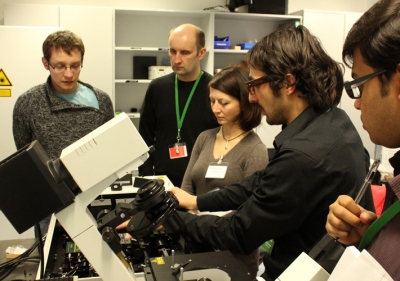March 2, 2012
4th European short course on time-resolved microscopy and correlation spectroscopy
Lectures and hands-on sessions covered FLIM, FLIM-FRET, FCS, FLCS and single molecule spectroscopy
 For the fourth time, PicoQuant GmbH has organized the European short course on "Time-Resolved Microscopy and Correlation Spectroscopy", held in Berlin, Germany from February 14 to 16, 2012. The line-up of world leading experts in time-resolved fluorescence microscopy gave the 39 participants from all around Europe the opportunity to hear about the newest applications and how to use the cutting-edge equipment of PicoQuant, Nikon, Leica and Olympus.
For the fourth time, PicoQuant GmbH has organized the European short course on "Time-Resolved Microscopy and Correlation Spectroscopy", held in Berlin, Germany from February 14 to 16, 2012. The line-up of world leading experts in time-resolved fluorescence microscopy gave the 39 participants from all around Europe the opportunity to hear about the newest applications and how to use the cutting-edge equipment of PicoQuant, Nikon, Leica and Olympus.
Dr. Christian Eggeling, member of the Department of NanoBiophotonics at the Max-Planck-Institute, Göttingen opened the course with a lecture about the basics of microscopy. He gave an overview from the fundamental use of microscopes to new applications like Stimulated Emission Depletion (STED) as a way to increase the resolution beyond the Abbé resolution limit. Rainer Erdmann, Managing Director of PicoQuant then outlined the basic instrumental requirements necessary to perform time-resolved fluorescence microscopy with special focus on excitation sources, detector options and electronics for Time-Correlated Single Photon Counting (TCSPC).
The second day started with a lecture of Dr. Mark Hink from the University of Amsterdam in which he explained the basics of Fluorescence Correlation Spectroscopy (FCS) and Fluorescence Cross-Correlation Spectroscopy (FCCS). He stated in detail which factors have to be considered in order to accomplish successful FCS experiments. In the second talk Prof. Paul French from the Imperial College, London introduced the technique of Fluorescence Lifetime Imaging (FLIM) and showed applications in cell biology, drug discovery and clinical diagnosis.
The third day kicked off with a lecture of Prof. Jörg Enderlein from the Georg-August-University, Göttingen. He explained advanced concepts of FCS such as Fluorescence Lifetime Correlation Spectroscopy (FLCS) and 2-focus FCS (2fFCS). His talk was followed by a lecture about Förster Resonance Energy Transfer (FRET) by Prof. Fred S. Wouters from the University Medical Center of the Georg-August-University, Göttingen. He pointed out details on how to design the right FRET-based biosensors for a specific application.
Practical sessions in the afternoons were held by application specialists from PicoQuant, Nikon, Leica and Olympus. Each experimental station focused on a specific time-resolved measurement method such as FLIM, FLIM-FRET, FCS, as well as single molecule experiments. The instruments presented included a time-resolved confocal microscope from PicoQuant and laser scannnig microscopes from Nikon, Leica and Olympus, each upgraded with time-resolved data acquisition capabilities using the dedicated kit from PicoQuant. One additional session was dedicated to data analysis using PicoQuants SymPhoTime software where participants had the chance to test all features of the software by analyzing previous measured data.
The participants especially liked the compact and comprehensive program, including the high quality of the lectures and instructive hands-on experiments. In summary, it was a memorable course bringing theory, instrumentation and various fields of application together.
Downloads
Contact
General contact
Info request
info@picoquant.com
+49 (0)30 1208820-0
Press contact
Nicole Saritas
mkt@picoquant.com
+49 (0)30 1208820-0

